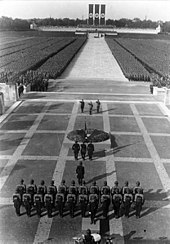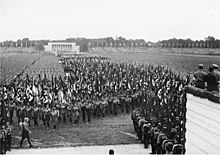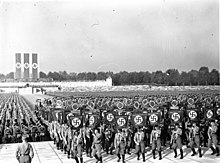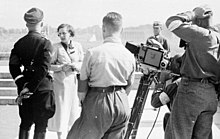Nazi party rally
The term Reichsparteitag is generally used today to refer to the Nazi Party Rallies, which took place from 1923 to 1933 in the Weimar Republic and after the NSDAP came to power during the National Socialist era . From 1933 onwards, they were held as propaganda events for the leadership of Adolf Hitler .
history
The first party rallies of the NSDAP took place in Munich in 1923 (January 27 to 29) and in Weimar in 1926 (July 3 to 4) . In 1928 the Nazi Party Congress was canceled due to a lack of funds. Two more were held in Nuremberg in 1927 (August 19-21) and 1929 (August 1-4) . After serious clashes between National Socialists and Communists occurred at the 4th Reich Party Congress in 1929, the Nuremberg city administration prevented the Nazi party rallies from taking place in 1930 and 1931. In 1932, the NSDAP again refrained from holding a Nazi party rally due to lack of funds. Nuremberg was initially chosen as the venue for pragmatic reasons. Nuremberg was relatively central in the German Empire and had the Luitpoldhain, a suitable meeting place for large events. The NSDAP was also able to fall back on the well-organized party in Franconia under Gauleiter Julius Streicher for the organization . The Nuremberg police were sympathetic to the event. The venue was later justified by placing the Nazi party rallies in the tradition of the Nuremberg Diets of the medieval-imperial Holy Roman Empire of the German Nation .
After 1933, they were held as Reich party rallies of the German people in Nuremberg in the first half of September and usually lasted eight days. According to the Nazi propaganda , the solidarity between the leadership and the people was to be demonstrated. The number of participants rose to over half a million, with visitors from all branches of the party, the armed forces and the state.
The party congresses of the NSDAP were organized by the Zweckverband Reichsparteitag under the Nuremberg Mayor Willy Liebel .
From 1933 onwards, every party congress was given a programmatic title that referred to specific events:
- August 30 to September 3, 1933: The title Reichsparteitag des Sieges refers to the takeover of power and the victory over the Weimar Republic (actually: Congress of Victory ).
- 5th – 10th September 1934: This party congress initially had no motto. Subsequently it was called the Reich Party Rally of Unity and Strength , the Reich Party Rally of Power or, with reference to the Riefenstahl film " Triumph des Willens ", the Reich Party Rally of the Will (there was also the same name for the Reich Party Rally, i.e. the Triumph of the Will ).
- 10-16 September 1935: Reich Party Rally of Freedom : Freedom meant the reintroduced general conscription and the associated 'liberation' from the Versailles Treaty .
- 8-14 September 1936: Reich Party Rally of Honor : the occupation of the Rhineland restored German honor in the eyes of the NSDAP leadership.
- 6-13 September 1937: At the Labor Party Congress , reference was made to the reduction in unemployment since the takeover of power.
- 5th - 12th September 1938: Because of the annexation of Austria to Germany, this event was called the Nazi Party Congress Greater Germany .
- 2nd-11th September 1939: The name Reich Party Rally for Peace was intended to document Germany's will for peace to the population and abroad. It was supposed to start on September 2nd, but was canceled at the end of August without giving a reason. On September 1, began with the invasion of Poland of the Second World War .
procedure

An important part of the Nazi party rallies was the religion-like orientation towards Adolf Hitler . For example, the largest organ in Europe, a Walcker church organ , was briefly installed in the Luitpoldhalle . It was played, among other things, for the opening ceremony of the 1935 Reich Party Rally.
An important part of the Nazi party rallies were also numerous marches and parades by all organizations of the Nazi state (Wehrmacht, SA , SS , Hitler Youth , Reich Labor Service , Association of German Girls, etc.) and the proclamation of important cornerstones of the National Socialist ideology. During the Nazi party rally in 1935, for example, the Nuremberg Race Laws “for the protection of German blood” were promulgated. The demonstration of power by the NSDAP associations was not limited to the Nazi party rally grounds away from the city center: various formations marched past the Führer on the main market square in the heart of the old town - from April 1933: Adolf-Hitler-Platz - closely linked the party rally to the city. Numerous spectators (many of them enthusiastic) lined the route of the marchers across the city center. Special wooden stands were built on the Paradeplatz itself. The long trains of the masses through the flag-adorned historical backdrop of Nuremberg created the desired connection between the former "City of the Reichstag" and the "City of the Reich Party Rallies". The party without a long history tried to build on the past of the traditional community.
At every party congress there were also unplanned degenerations in downtown Nuremberg; some of the participants did not allow themselves to be tied to the strict procedure planned by the party leadership.
Between 1935 and 1938, a festival performance of Richard Wagner's Mastersingers was part of the program on the opening day. Hitler was an admirer of Richard Wagner and his music; this opera was considered an expression of a “heroic German” worldview .
Nazi Party Rally Grounds
→ Main article: Nazi party rally grounds
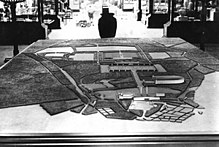
With the expansion of the party convention grounds in 1935, Nuremberg was given the nickname City of the Nazi Party Rallies , which was also intended to symbolically represent the party's claim to power. The title was proclaimed by Hitler at the start of the 1933 party congress (it began on September 1, 1933); it became official in 1936 with a ministerial decree. Albert Speer developed the overall concept for the 11 km 2 Nazi party rally grounds from 1934 to 1936; From 1935 onwards, under great time pressure, the plans began to be realized. The site was never fully completed. With the Luitpoldarena, the largest parade ground in the world at the time was created for 150,000 participants. In addition, the congress hall for 50,000 visitors (not completed), which has housed the Documentation Center of the City of Nuremberg since 2001 , the zeppelin field - intended for 250,000 participants and 70,000 spectators - and a large area as a camp for participants were built. Half of the March field with stands for 500,000 spectators was completed. The German Stadium , planned for 400,000 spectators as the largest sports stadium in the world, remained largely in the planning stage; the foundation stone and excavation work only took place. Today's Silbersee and Silberbuck (a heap of rubbish and debris from the whole city) are on the site and fill the excavation pit. The stone extensions of the Luitpold Arena built after 1933 - as they are e.g. They can be seen, for example, in the propaganda film “ Triumph des Willens ” - were demolished and renatured after the war (conversion as urban green space for recreational purposes). The areas of the Nazi party rally grounds are used today for various events.
The facility was intended to demonstrate the Nazi regime's claim to power both internally and externally. The purpose of the buildings was to give visitors the feeling of being part of something big, but of being small and insignificant themselves. They supported the leader myth and should strengthen the national community through the community feeling. With the use of flak headlights as a light dome at night, Hitler's appearance was spectacularly staged.
Propaganda films
About the party rallies of 1933 and 1934 turned Leni Riefenstahl each one Propaganda - Documentary . Based on the motto of the party congress, she called the first film The Victory of Faith . In the 5th thematic block, the film also portrays the airship Graf Zeppelin , which was used for propaganda purposes at this Nazi party rally. After the Röhm Putsch (mid-1934) this film was withdrawn from circulation.
The propaganda event of 1934 was turned into the film Triumph des Willens by Riefenstahl with 16 camera teams and over 100 employees . She received the German Film Prize and the gold medal in Venice for the effective and powerful images .
Another Nazi propaganda film that deals with the Nazi party rally issue is Der Marsch zum Führer from 1940.
Numerous newsreel reports dealt with Nazi party rallies (up to June 1940 Ufa-Tonwoche , June 25, 1940 - March 22, 1945 Die Deutsche Wochenschau ).
Others
Members of the BDM ( Bund Deutscher Mädel ) and Hitler Youth also went to the Nazi party rallies . Pregnancies were subsequently found in 900 of the BDM members who returned from the Nazi party rally in Nuremberg in 1936.
Most of the participants traveled to and from the event by Deutsche Reichsbahn trains . Up to 1.3 million visitors (1938) left within a short time. At Nuremberg main station , there were sometimes dispatch intervals of 80 seconds. Between arrival and departure special trains were parked up to 400 kilometers from Nuremberg, for example in Dresden. The Dutzendteich and Fischbach stations were expanded in the 1930s. The construction of a huge train station in Nürnberg Märzfeld in order to bring visitors directly to the Nazi party rally grounds remained unfinished.
See also
literature
- Yvonne Karow: German victim: cultic self-extinction at the Nazi party rallies of the NSDAP . Akademie Verlag, Berlin 1997, ISBN 3-05-003140-9 . (Habilitation thesis FU Berlin 1994)
- History for everyone e. V. (Ed.): Site inspection - The Nazi Party Rally Grounds in Nuremberg . Sandberg Verlag, Nuremberg 2002, ISBN 3-930699-37-0 .
- Markus Urban: The consensus factory. Function and perception of the Nazi party rallies 1933–1941 . Vandenhoeck & Ruprecht, Göttingen 2007, ISBN 978-3-89971-366-4 . (Dissertation University Erlangen-Nuremberg 2006)
- Helmut KH Strauss: Richard Wagner's opera 'Die Meistersinger von Nürnberg' on the occasion of the party rallies of the NSDAP. In: Communications from the Association for the History of the City of Nuremberg. 96, 2010, pp. 267-291.
- Siegfried Zelnhefer: The Nazi party rallies of the NSDAP . Korn & Berg, Nuremberg 1991, ISBN 3-87432-118-5 . (Dissertation University of Erlangen, Nuremberg, 1990)
Web links
- Documentation Center Nazi Party Rally Grounds Nuremberg
- Shoa.de: Nazi party rallies
- German House of History: Nazi Party Rallies 1933–1939
- Information page about buildings in Nuremberg 1933–1945
Footnotes
- ↑ History for All e. V. (Ed.): Site inspection. 2., revised. Edition. Nuremberg 1995, p. 78.
- ↑ Excerpt from Michael Gerhard Kaufmann "Organ and National Socialism". (PDF; 3.8 MB) To the Walcker organ Opus 2432 built in 1934/35 for the Martin Luther Church in Berlin-Mariendorf. (No longer available online.) Musikwissenschaftliche Verlagsgesellschaft mbH, Kleinbittersorf, 1997, archived from the original on December 1, 2017 ; Retrieved November 29, 2017 . Info: The archive link was inserted automatically and has not yet been checked. Please check the original and archive link according to the instructions and then remove this notice.
- ↑ Get started! on: www.bayerische-staatszeitung.de , February 1, 2013.
- ↑ Ernst Piper : The lazy Nazi magic of Nuremberg. In: Spiegel online. August 30, 2008.
- ↑ Technical explanations of the light dome with numerous illustrations (PDF; 4.9 MB).
- ↑ Tomcat, who also reports a case according to which a BDM girl who had just become a mother named 13 people as possible fathers. "In order to put a stop to at least the worst debauchery, the BDM was forbidden to camp outside in 1937." ( Michael H. Kater : Hitler Youth . Translated from the English by Jürgen Peter Krause. Primus-Verlag, Darmstadt 2005, ISBN 3- 89678-252-5 , p. 95).
- ^ DB Museum (ed.): In the service of democracy and dictatorship: The Reichsbahn 1920–1945 (= history of the railroad in Germany . Volume 2 ). 2nd Edition. Nuremberg 2004, ISBN 3-9807652-2-9 , pp. 80, 82 .
- ↑ Review of H-Soz-Kult

